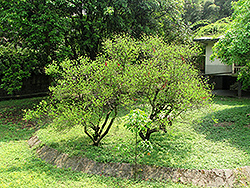It's all about ...
plants

Bidwell's Coral Tree
Erythrina x bidwillii
Height: 15 feet
Spread: 15 feet
Sunlight:
![]()
Hardiness Zone: 8b
Other Names: Shrub Coral Bean, Fireman's Cap
Description:
A deciduous to semi evergreen shrub or small tree when protected from frost; roots are hardier so this variety will die back and re-emerge in spring in colder areas; dazzling red flower clusters from early summer to fall; attracts hummingbirds
Ornamental Features
Bidwell's Coral Tree features showy clusters of red tubular flowers at the ends of the branches from early summer to mid fall. Its pointy leaves remain green in colour with distinctive light green veins throughout the season.
Landscape Attributes
Bidwell's Coral Tree is a multi-stemmed perennial with a more or less rounded form. Its medium texture blends into the garden, but can always be balanced by a couple of finer or coarser plants for an effective composition.
This is a relatively low maintenance plant, and should only be pruned after flowering to avoid removing any of the current season's flowers. It is a good choice for attracting bees, butterflies and hummingbirds to your yard. It has no significant negative characteristics.
Bidwell's Coral Tree is recommended for the following landscape applications;
- Mass Planting
- Hedges/Screening
- General Garden Use
Planting & Growing
Bidwell's Coral Tree will grow to be about 15 feet tall at maturity, with a spread of 15 feet. It has a low canopy with a typical clearance of 1 foot from the ground. Although it is technically a woody plant, this fast-growing plant can be expected to behave as a perennial in our climate if planted outdoors over the winter, usually regrowing from its base (crown) the following year. As such, gardeners should take into consideration that it will perform differently than it would in its native habitat.
This plant should only be grown in full sunlight. It prefers to grow in average to moist conditions, and shouldn't be allowed to dry out. It is not particular as to soil type or pH. It is somewhat tolerant of urban pollution. Consider applying a thick mulch around the root zone in winter to protect it in exposed locations or colder microclimates. This particular variety is an interspecific hybrid. It can be propagated by cuttings; however, as a cultivated variety, be aware that it may be subject to certain restrictions or prohibitions on propagation.
This plant is not reliably hardy in our region, and certain restrictions may apply; contact the store for more information.

